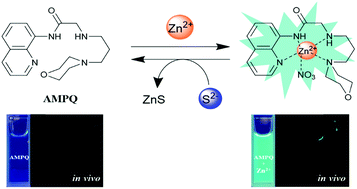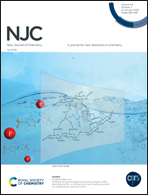Sensing of zinc ions and sulfide using a highly practical and water-soluble fluorescent sensor: applications in test kits and zebrafish†
Abstract
A novel practical fluorescent sensor AMPQ (2-((3-morpholinopropyl)amino)-N-((quinolin-8-yl)acetamide)) was designed and synthesized. In bis-tris buffer, AMPQ displayed highly practical and selective fluorescence recognition of Zn2+, clearly discriminating it from Cd2+ and other cations. Moreover, the AMPQ–Zn2+ complex exhibited a fluorescence “turn-off” response to S2− with exceptional selectivity via a S2−-induced Zn2+ displacement approach. The detection limits (0.29 and 2.39 μM) of AMPQ for Zn2+ and S2− were much lower than the WHO guidelines (76.0 and 14.7 μM), respectively. Importantly, sensor AMPQ could be applied in various practical applications such as in real water samples and test kits. In particular, AMPQ could monitor both Zn2+ and S2− in live zebrafish, with a detection limit of 0.74 μM for Zn2+, which is the lowest among sensors previously reported for the relay detection of Zn2+ and S2−. The sensing process of AMPQ toward Zn2+ and S2− was evaluated by UV-vis and fluorescence spectroscopy, Job plots, ESI-MS, 1H NMR titrations, and calculations.



 Please wait while we load your content...
Please wait while we load your content...